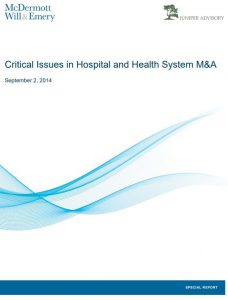Critical Issues in Hospital and Health System M&A
 Since the enactment of the Affordable Care Act, the pace of hospital and health system consolidation has accelerated to a level not seen since the late 1990s, when hospitals were reacting to the formation of HMOs. The year 2013 saw a total of 87 consolidation transactions, following 105 in 2012. This volume represents a significant increase over 58, the median number of transactions completed each year between 2001 and 2011.
Since the enactment of the Affordable Care Act, the pace of hospital and health system consolidation has accelerated to a level not seen since the late 1990s, when hospitals were reacting to the formation of HMOs. The year 2013 saw a total of 87 consolidation transactions, following 105 in 2012. This volume represents a significant increase over 58, the median number of transactions completed each year between 2001 and 2011.
Unlike the last wave of consolidation, which was driven primarily by financial and reimbursement considerations, today’s hospital mergers are just as likely to be between financially strong partners as they are to be in response to challenged operations or economics. Hospital companies increasingly are turning to mergers and acquisitions as a tool to improve quality, manage risk, access capital and contend with the changing regulatory environment. The articles in this collection explore the drivers of the current wave of consolidation, address the causes of transaction failures and review the range of structural alternatives available in the marketplace.
Preparing a Hospital or Health System for Sale or Partnership Transactions
Currently, horizontal consolidation (hospital-to-hospital combinations) is keeping pace with vertical consolidation (hospital acquisitions of ancillary providers and physician groups). To address perceived inefficiencies and quality of care issues, hospitals are attempting to form larger enterprises to create scale, expand geographically, manage risk, access capital, contend with the changing regulatory environment and more effectively manage the health of the populations they serve. Despite the trend toward consolidation, completing hospital consolidation transactions is more challenging than ever, as demonstrated by an alarmingly high failure rate. Over the past several years, about 25 percent of announced partnerships have failed after the signing of a letter of intent and before close. A “busted deal” may cause economic harm and operating disruption to all involved.